Matador Network's Blog, page 2279
April 22, 2014
African safari perfection [pics]
MATADOR recently traveled to South Africa to experience the phenomenon of Singita — the most successful high-end safari brand in sub-Saharan Africa.
Singita has lodges in Tanzania, Zimbabwe, and South Africa and is building new projects in Rwanda and Mozambique. We got the chance to experience four of their lodges in South Africa.
In this photo essay, you’ll get an idea of what it’s like to be a guest at Singita’s Kruger properties: Lebombo and Sweni. 
Words by Ross Borden; photos by Scott Sporleder.
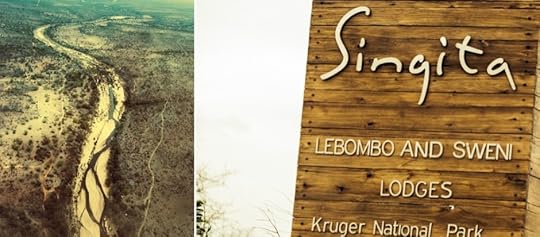
1
Singita’s Kruger resorts
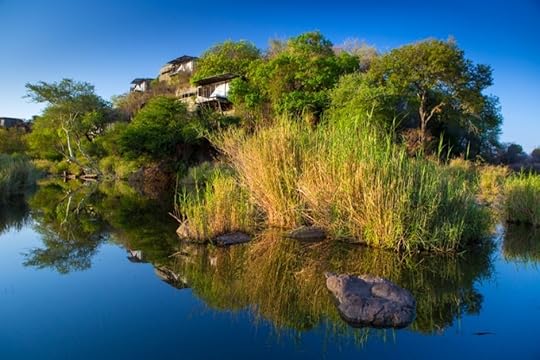
2
Looking up at the suites of Lebombo
The rooms at the Lebombo lodge are spread across a ridge that runs right down to a major river in the park. We stayed at one of the suites pictured here, which looks out directly over the river. Although it’s a longer walk to and from reception, the sights and sounds of wildlife at the river made it feel like we were out on a game drive even during downtime at the room.

3
The world’s coolest living room
The center of community life at Lebombo happens here in this massive and architecturally impressive commons area. It's an open-air space where every day begins with coffee/tea and breakfast. Everything from the view to the art and furniture makes this room unforgettable.

See more: Singita: The best safari lodges in all of Africa

4
Witnessing a live hunt took patience
I've been on many safaris, and I know how rare it is to see a live hunt take place. We'd spent 20 minutes watching this beautiful female cheetah stretch out after a nap as if she was preparing to hunt. Two other Singita Land Rovers sat next to ours, waiting for the action to begin. No impala crossed the open field where she lay in wait, and everyone was getting antsy. The sun was hot, and the other two vehicles gave up and moved on. Luckily we stuck with her and drove parallel to her as she switched strategy and stalked into thick brush. Almost immediately, she ran right into some impala in the trees, and the chase was on.

5
The kill…and a short-lived victory
Quickly, our guide spotted where the cheetah had tripped up the panicked impala and had her by the neck, asphyxiating her with a death grip. We drove up so close to the kill that it startled the cheetah, and she momentarily loosened her grip on the impala as she looked up at us. The impala made one more desperate attempt at escape, but with a few bounds, the cheetah had her again, and it was all over. The cheetah lay beside her kill and rested for a full 20 minutes before feeding. Another half hour passed, and the cheetah was chased off the kill by a large male lion who had seen the vultures circling from miles away.

6
A photogenic elephant
One of the many dozens of elephants we saw in our four days at Lebombo and Sweni.
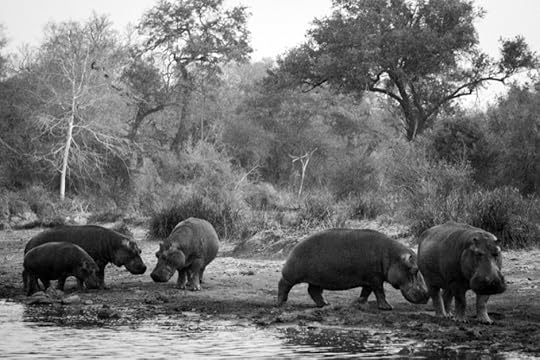
7
Hippo out of water!
A semi-rare sighting, this pod of hippos decided to reveal themselves to us just after sundown. Hippos typically spend 95%+ of the day in the water to protect their sensitive skin, and they get out at night to feed on plants along the bank. By the numbers, hippos are also Africa’s most dangerous animal, and since they feel safest in the water, finding yourself between them and the water when they're on land can be a deadly place to be.
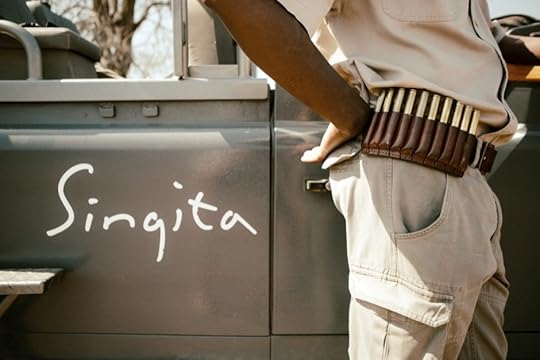
8
Knowledge, not bullets, keeps you safe
Although every guide at Singita carries a rifle in each Land Rover and wears a belt full of bullets, they’re never used. Each guide brings a wealth of knowledge to the table regarding animal behavior and how to stay safe in the bush.
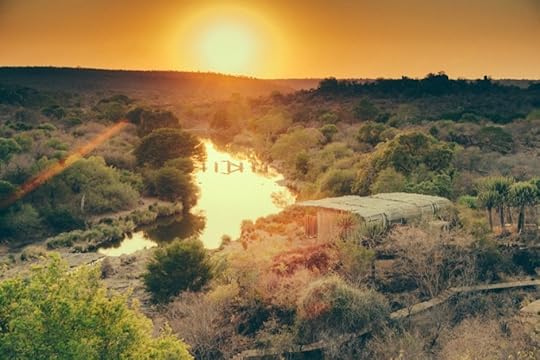
9
Sunset at Lebombo
A roof of one of the suites at Lebombo looking out on the river below.
Intermission
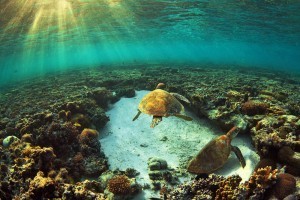
A dream realized on Lady Elliot Island [pics]

Singita: The best safari lodges in all of Africa
[image error]
Hunting the Northern Lights in Fairbanks, Alaska
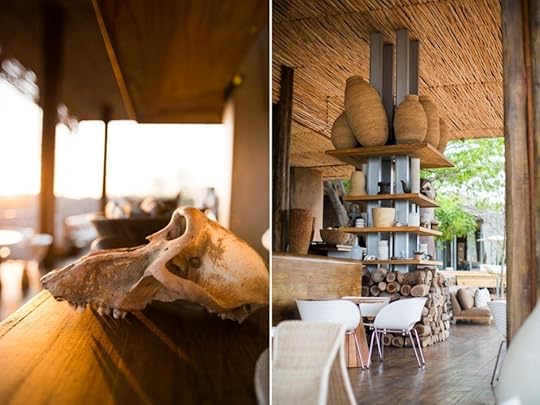
10
Skulls and local art
Much like Singita’s other South African resorts in Sabi Sands, Lebombo is full of amazing art, natural history, and local artifacts.
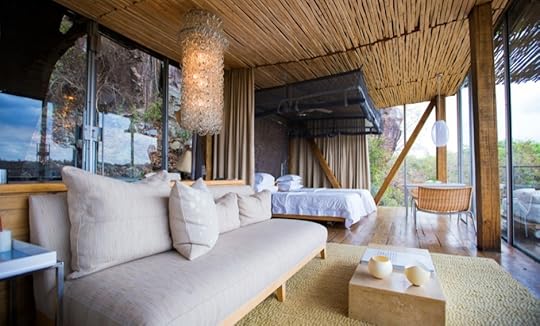
11
Living in style
Like the common spaces at every Singita property, the suites are all super stylish, but the real genius of these rooms is their isolation from each other and the privacy guests enjoy.

12
Singita's solitude
Somehow they’ve spaced each room out from the next so that each guest room has complete privacy from other guests and staff, as well as an individual and intimate connection to the surrounding nature.
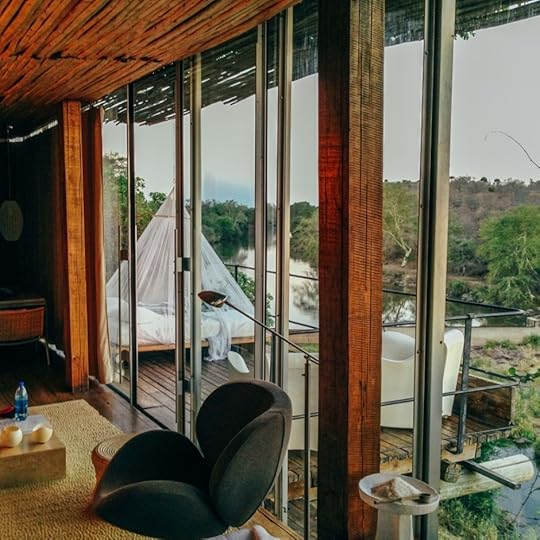
13
Sounds of the night
One of the nights at Lebombo I woke up at 4am, and instead of going back to sleep I went out and lay under the mosquito net, which the staff hung above the deck bed each evening. I listened to the night for hours—a thrilling dialog of wildlife from buzzing beetles to lions roaring at each other right across the river.

14
The buffalo and the bird
A Cape buffalo pants like a dog in the heat of the day, while the charismatic red-billed hornbill surveys the plains below his perch.
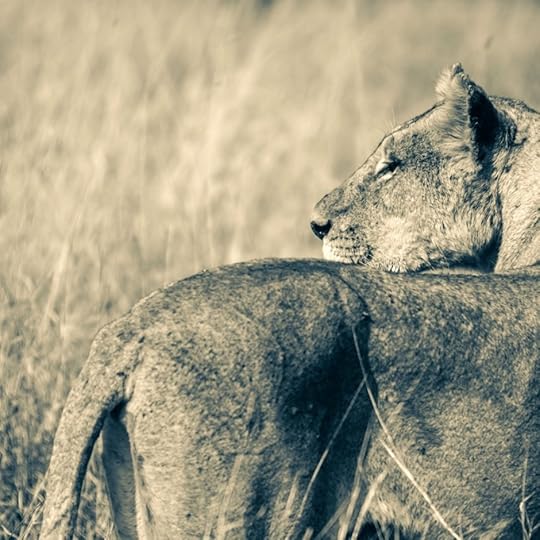
15
A lion’s world
If you want to see cats, this is the place to be. Lebombo and Sweni are well known for their big cat populations, especially lions. This makes for a very competitive landscape for the male lions in this part of Kruger, as they compete for rights to the females.
Intermission
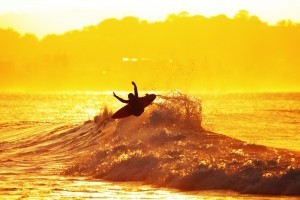
A look inside the surf culture of the Gold Coast, Queensland
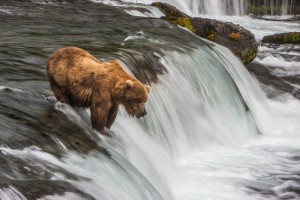
Coastal Brown Bears of Katmai National Park, Alaska [pics]

Stacked infinity pools in a Bali rainforest [PICs]

16
Over the hill
This large male, who we found with a full stomach fresh off a feast, has been the dominant male in one of the local prides for three years and has the scars to prove it. Three different younger males are now trying to push him out, and it likely won’t be long till he either dies in a fight or strikes out on his own and abandons the pride.

17
Lazy croc
The river that runs through this part of Kruger is teeming with crocs. If you see them lying on the bank basking in the sun, they’ll seldom move a muscle, but when they want to be they're fast—on land and in water.
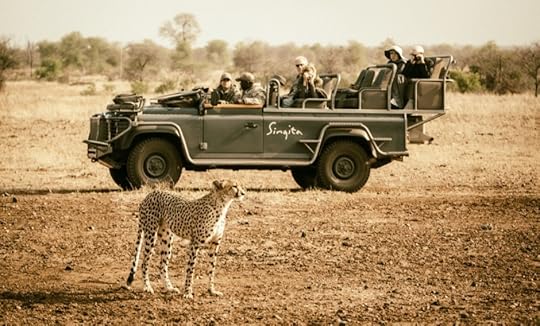
18
Classic Singita
Singita guests wait for a female cheetah to show them the speed and grace of an evening hunt.
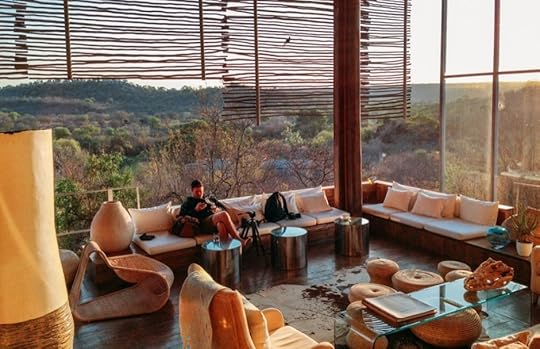
19
World's most beautiful breakfast room
This is where you'll start every morning at Singita Lebombo.
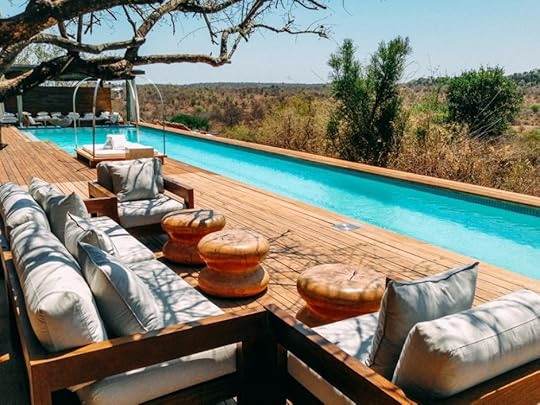
20
Beating the heat
Between each game drive you'll be treated to an amazing lunch, and if you get too hot by the pool you can read a book in the shade or take a dip.

21
Spoiled rotten
And just when you thought the luxury service couldn't get any better, your guide and tracker will stop the vehicle during each evening game drive and set up a cocktail bar right there in the middle of the bush. Snacks and cocktails surrounded by wildlife...magic.

22
Predator and prey
Left, we have the magnificent male kudu with his large spiral horns. The kudu is one of the biggest antelope in Africa. Right, a leopard leads us back to her kill, which she's dragged into the brush so as not to attract attention from opportunistic hyenas or lions who'd try to steal it.

23
Protective over her kill
Typically, big cats act as though they're oblivious to your presence in the vehicle, but not the case when they're guarding a fresh kill. As we drew near to this small but aggressive female leopard, she let us know we were getting too close.

24
Not a friendly cactus
The euphorbia cactus grows all over this arid region of Kruger and is super poisonous to humans.

25
The oxpecker
This small bird lives off the parasites it finds living on large mammals, from rhino to Cape buffalo to small antelope like this impala. The host animal understands the service the bird is providing and is amazingly patient with it, even when the bird's standing on its face.

26
Bachelor lion
This young male lion faces a hard couple years fending for himself outside any major pride until he gets mature enough to attempt to overthrow a dominant male.

27
Co-moms of the pride
Lionesses share responsibilities in the pride, from taking care of the cubs to hunting game for the pride to eat. Most females specialize in one of the two roles.

28
Stealing the scraps
We drove up on a group of hyenas tearing up the final scraps of a wildebeest killed by a group of lions during the night. Hyenas have the strongest jaws of any mammal (even stronger than lions) and are ultimate survivalists. They also live in a matriarchal society where the lowest-ranking female is more powerful than the highest-ranking male.

29
Singita Sweni
Just down the road from the Singita Lebombo lodge, you'll find another amazing property called Sweni. This lodge is literally on the river, whereas Lebombo is higher on the ridge. It comes with an attached spa (treatments are available to guests from both properties) and an amazing little art gallery where most things are for sale.

30
Part of a dazzle
Did you know a large group of zebras is called a "dazzle"?

31
Young guns
In the pitch dark of night on our way home from a late game drive, we came upon two of the three mature males currently challenging the dominant male from one of the local prides. They looked big, strong, and healthy and had already recruited a couple females from the pride.

32
Breakfast at Sweni
The days at Sweni begin much like those at Lebombo: a light breakfast and tea/coffee overlooking a spectacular view.

33
A well-protected friend
Under constant threat from poachers, black and white rhinos in Kruger are well protected with heavy round-the-clock security.

34
A hungry stare
Making eye contact with one of the young, hungry-looking male lions only a few feet away from your open-top vehicle can be quite a moment.

35
An eating safari
From tea to lunch to dinner to snacks, the culinary experience will blow your mind at Singita.
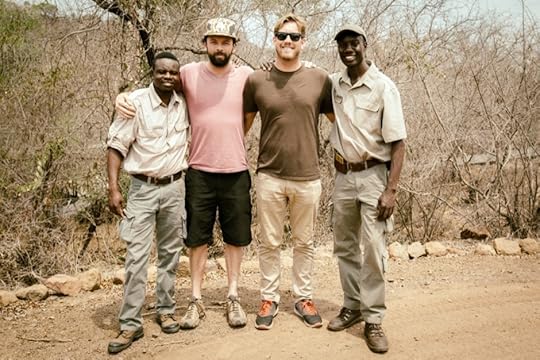
36
New friends
Thanks to everyone at Singita Lebombo and Sweni, especially our amazing guide, Enos, and tracker, Sunday.
Matador visited the Lebombo and Sweni lodges as guests of our friends at Singita.
The post African safari perfection: A look inside Singita’s resorts in Kruger National Park appeared first on Matador Network.

April 21, 2014
Smart phones & travel infographic
TEN YEARS AGO, I could not book an entire vacation by surfing the net on my mobile phone. I don’t even think I could surf the internet at all, and if I could, it was super slow, ate up a ton of data, and it looked super ghetto. It’s amazing how, in ten years time, we can not only plan a trip, but send vacation photos to our friends and family in real-time, and even have a lengthy conversation over wifi, using mobile technology. I’ve been resistant to embrace it, but at the same time, these innovations have made traveling both easier, and more fun.
Check out this infographic to see how mobile technology has completely transformed the way we travel. 

Explore more visuals like this one on the web’s largest information design community – Visually.
The post The way we travel is totally different, thanks to mobile technology [infographic] appeared first on Matador Network.

16 realities you’ll face on a road trip

Photo: José Cuervo Elorza
1. Failed plans
After making it to Vail, CO, and realizing that lift tickets are $200, you might just decide to go to a marijuana dispensary and lie comatose on your friend’s bed all weekend.
2. A lowering of personal standards for restroom facilities
It may have been sketchy when you had to walk through a barred door in the back of the warehouse. It may have been gross when you had to walk by a pile of fly-infested pork on the ground. But it was downright disgusting when you just sat down on the seat because there wasn’t any toilet paper, and your thighs were too sore to squat.
3. Visits to random-ass places just to get out of the car
E.g.: Webb’s 2-3-1 BBQ on route 231 in Alabama (excellent). The Lion’s Den Adult Superstore in Louisiana (not excellent).
4. A reality check on the kinds of people that live in America
You’ll meet the Harvard-grad business kid at his bachelor party, trying to touch the dancers at a Bourbon Street strip club. The happy-go-lucky carpenter making ends meet in a rural Florida trailer, living off of tuna-fish sandwiches. You’ll get to decide who’s the genius and who’s the whack-job.
5. ‘Must-see’ places that are almost always a letdown
You’ll quickly realize that Bourbon Street smells like the vomit of a thousand fraternity pledges. And holes like Snake & Jakes and the Oak Street Cafe are the real reasons you came to New Orleans.
6. ‘Scenic’ routes that are anything but scenic
Meandering down the ‘coastal route’ through Florida’s panhandle sounds lovely when you’re not doing it. But when you’re stuck at your 27th stoplight in Panama City, and you just watched some drunk kid in neon dump it on a scooter in a henna tattoo parking lot, you’ll hate yourself and all of American-kind.
7. An improvement of your ability to fall asleep anywhere
On a balled up egg-carton mattress in someone’s closet in New Orleans. On top of a polyester bedspread in a hotel advertising “colored TV.” In a Walmart parking lot, curled around the spare tire in the bed of your truck.
8. Having to explain yourself
People will want to know exactly what you’re doing and why you didn’t just take one of those airplane things. Your waitress in that Austin 24hr diner. The bartender in that Alabama dive. The cop accusing you of drug-running in rural Mississippi.
9. Unexpected camaraderie from other truck drivers (if you drive a truck)
When you need to switch lanes in a traffic jam on Route 65, that Prius from Oregon is not going to let you in. It’ll be the GMC with an Alabama license plate and an NRA decal.
10. Billboards
Especially in that bossy, presumptive, omniscient POV: “Pregnant? Let God’s hand help.” “God is like Allstate, you’re in good hands.” “Go to church or the devil will get you.”
11. Singalongs to terrible country music
There’ll be some farmers’ daughters, some chainsaws, and a whole lot of sexual innuendos dealing with manually operated, four-wheel-drive trucks.
12. Catching yourself being a tourist
If you freak out and cry at the sight of a dolphin’s dorsal fin in Apalachicola. If you drop 10 bucks to tour the Hank Williams ‘museum’ in Montgomery. If you impulse buy a cowgirl hat in Tennessee. It’s going to be okay. Your pride will come back.
13. A regrettable tendency towards snacking
When you’re squishing a purple spice drop between two saltine crackers to make your version of a savory and slightly sweet sandwich, you’ll wonder, “Am I pregnant?”
14. Working hard to save a buck
After driving to seven different hotels on the same strip just so you can compare prices, you’ll realize that you’re just as cheap as your last boyfriend, and you only saved $1.86.
15.Getting to know your travel partner overly well
Their hopes: “When we get home I’m going to quit smoking and buy six more dogs.”
Their dreams: “You were there, but you were kind of just floating in an inner tube with a bitchy look on your face…and there was a catfish? And your cousin was there, but he wasn’t your cousin…”
Their desires: “I wish you’d take your top off while driving.”
16. A desperate need to ‘be on vacation’
No matter your reason for road tripping — delivering a vehicle, moving, a hatred of airport food — at some point you’ll feel tired of groveling and this desperate need to just Airbnb that shit for a few nights. To get a place. A shower. To get some dinner and get drunk. 
The post 16 realities you’ll face on a road trip appeared first on Matador Network.

Your shrimp may have killed a whale
As a child, when I went out fishing, we’d cast our lines, wait for a while, and then whatever bit was reeled in and later cooked for dinner. There wasn’t ever a problem with waste: The fish we caught were the ones we ate, unless they were smaller than was legally allowed, in which case we returned them.
Modern-day industrial fishing, unfortunately, can’t function with that same level of efficiency, as it’s responsible for feeding millions of people, and not just a 10-year-old and his dad. In industrial fishing operations — thanks to the use of nets and other fishing technologies — they often catch fish and other marine life they weren’t intending to catch. This is called bycatch, and the bycatch is often killed and, because it wasn’t wanted in the first place, thrown back.
Bycatch — the fish that don’t end up on our plates — accounts for 90% of all fish caught. The worst offenders of this incredible bycatch inefficiency are shrimp and prawn trawlers. In fact, our attempts to catch shrimp, some of the smallest ocean creatures we eat, may be responsible for killing the largest creatures on earth: whales.
Considering how rapidly the oceans are losing their marine life, and considering the 10% that does make it to our plates feeds up to 20% of the world’s population, any reductions we could make to bycatch — to that 90% — would be incredibly beneficial to our world’s oceans. There are ways of doing it, but they’re expensive, and as such aren’t happening as quickly as they might otherwise.
Check out this infographic by Will Hood for more information and learn more about bycatch via the World Wildlife Fund. 
The post How that shrimp you’re eating may have killed a whale appeared first on Matador Network.

An close look at cockfights in Bali

All photos: Author
In 1958, anthropologist Clifford Geertz conducted a well-known study on Balinese life. For the first weeks of observation, the residents of the village where he and his wife stayed went out of their way to ignore the two interlopers.
Perhaps the only note Geertz had the opportunity to record between the time the couple arrived and the day they were finally accepted into the community was “the Balinese display an extreme distrust of outsiders.”

The Balinese tradition of tying steel blades to the feet of cocks for fights is different from other Indonesian islands, where the animals simply peck each other until one is exhausted.
The couple’s welcome did not arrive until the village hosted a cockfight to raise funds for a local school. Friends, family, and neighbors gathered in the banjar, placing wagers as round after round of roosters, with small blades tied to their feet, kicked each other to death.
It was the middle of a match when the police arrived. Someone forgot to pay off the local officials, and the “storm troopers” had come to collect. Machine-gun-toting officers ran to the middle of the arena, barking orders and waving their weapons around in the air.

A man holds up a bird that he is about to enter into a fight.
The Balinese responded to the intrusion in the only logical way one can when angry men carrying guns crash your peaceful gathering: They bolted. And as would be expected from any good anthropologist, Geertz and his wife acted on the “established anthropological principle, When in Rome…”
The chase that followed had the energy of a coming-of-age high school comedy. Adrenaline-fueled bodies flew “head-first” over walls and behind wicker screens. The village leader headed for the river, where he undressed so that he could claim to have been bathing and deny any knowledge of the affair.

Spilled blood is considered a sacrifice that will bring good crops.
The Geertz couple followed a man into his family’s compound where his wife, clearly knowing the routine, appeared with tea. The new friends instantly composed themselves and began the act of having been there all afternoon discussing…things.
Not only did the cover work for Geertz and most of the village, but the story of the two outsiders acting in solidarity with their Balinese hosts and taking part in the adrenaline-filled dash opened the doors to the community. Geertz and his wife were suddenly insiders, part of the group, warmly teased and welcomed.

Competitors face off.
The importance of this type of community acceptance is a place where anthropology, journalism, and living as an expat all overlap. If there is an expectation to see a community or truly be part of it on any level beyond its most surface elements, one cannot remain an outsider.
It took more than three weeks of photographing cockfights around Bali for me to approach a level of community acceptance. I had gone from a stranger with a camera to a familiar face. The price of my ticket, like everyone who attended, helped maintain community temples around the island. Gamblers who spoke next to no English knew my name, and we laughed together over meals of babi guling. There was even an invitation to one of the high-roller’s homes for a blessing and introduction to his third wife.

Balinese men look on as two birds begin a fight to the death near Ubud, Indonesia. It is a requirement for each temple on the island to host a cockfight every year.
As time progressed and more doors to the community opened, I developed an almost paradoxical discomfort with my comfort at the fights. I was happy to be part of the social environment and enjoyed the experience. But after, when I returned to my old community, I had to consider the more brutal aspect of what I felt welcomed into.
It was a gruesome sight to see an arena of 3,000 men who gambled small mountains of cash on animals that had no choice but to kick their competitors to death.

Gamblers call out their wagers, seeking partners to accept bets. In the past, cockfights were illegal in Bali, but because of their cultural importance the ban was ignored. The compromise between Balinese authorities and the central government was to allow the fights but ban gambling, as it is frowned upon by the Islamic values that are prevalent in the central government.
In a pursuit to justify my enjoyment, I ended up in a conversation with a man who was taking tickets. He didn’t dodge the ugly morality, but explained and accepted it in the context of a Hindu worldview that my community of origin may have had a harder time understanding.
He explained to me that Hindus do not believe in duality. Any action, no matter how vile at its first motion, must also be defined by its equal and opposite reaction. There is no denying the evil inside all of us. And if we are going to embrace it, as an honest person must, we should at least make something useful of it.

Money changes hands quickly as bets are placed and fights commence.
The thought of “making something useful of it” stayed with me until the next event. I looked around and saw the amount of money that went back into temples from ticket sales. I saw people who sold clothing and food at the fights that otherwise may have had no market. There was also chicken meat handed to men who had lost their bets.
What has changed between the time of Geertz’s acceptance and my warm welcome is that Bali is no longer an abstract far-off island. It is a destination, part of the international consciousness, and home to scores of expats. The new reality is that the interlopers are here to stay and their community has a role in not just being accepted, but also accepting the culture they have moved into.

The gruesome aftermath.
While all of us who have visited and lived on the island have in varying degrees been cautiously accepted by the Balinese, some of the culture remains hidden behind the initial distrust Geertz was exposed to. The question that now is posed to all of us interlopers is, will we act in solidarity with our Balinese hosts, take part in the community we have entered, acknowledging the bit of evil inside us and join in the adrenaline-fueled, head-first dive over the walls between us?

The discarded foot of a bird that just lost a fight. The meat is often given back to the losers of the fight as a way to hedge their loss.
As foreign communities become an increasingly prominent part of Bali, the question begs to be asked if the outsiders will truly accept the culture.

As soon at the match ends, the birds are plucked and prepared to cook at a later time.
By the standards of the community I was born into, there is no justifying a cockfight. But in the context of a community that supported its members and the evil inside all of us, I made my uneasy peace. 
The post An intimate look at cockfights in Bali appeared first on Matador Network.

10 shocking facts about the drug war

(via)
Some estimates say that in the US (beyond just the federal government), we spend over $51 billion total on the Drug War. We’ve spent over a trillion dollars since the beginning of the War on Drugs, during Richard Nixon’s presidency.
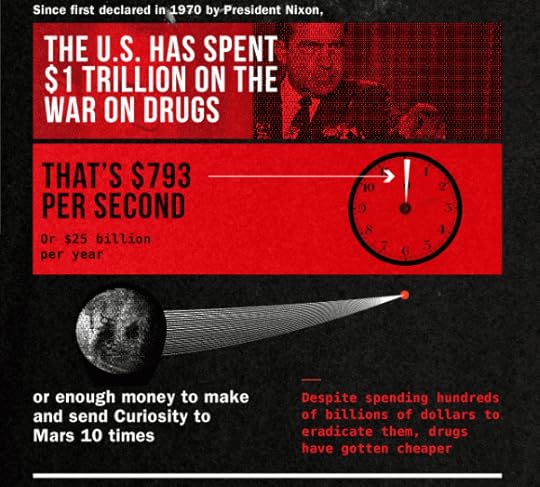
(via)
2. The War on Drugs forces police to focus on nonviolent drug offenders, rather than on violent criminals.
3. 82% of all drug arrests are for possession only, according to the group Law Enforcement Against Prohibition (LEAP).
And a large number of them are for marijuana possession:

(via)
4. Drug arrests have significantly contributed to our growing, unsustainable incarceration rates.

(via
1.55 million Americans were arrested in 2012 alone on nonviolent drug charges.

(via)
5. Since it’s easy to make possession arrests, the War on Drugs has led to shoddy police work.
David Simon, creator of the show The Wire, explains how:
From the documentary The House I Live In.
6. The War on Drugs is racially biased.
Former DEA Agent and US Marshal Matthew Fogg explains:

)via
7. Studies have found that treatment, not enforcement, is the best way to decrease drug abuse.
Treatment of drug abusers would also save us billions of dollars thanks to lower incarceration rates, lower recidivism, and increased employment among addicts. Former Boston Prosecutor John Amabile explains how drug policy should be treated as a health issue instead of a criminal issue:
8. If we legalized and then taxed illegal drugs at the same level as alcohol and tobacco, we could make $46.7 billion a year in tax revenues.
Colorado’s experiment with pot legalization is already earning them millions:

(via)
9. Ending the Drug War would go a long way towards stemming the AIDS epidemic.

(via)
10. Our Drug War is also fueling Drug Wars in a number of other countries — from Colombia to Afghanistan to Mexico.
Mexico’s Drug War alone has resulted in over 70,000 deaths since 2006. This is more than ten times the amount of Americans that have been killed in Iraq and Afghanistan.

(via)
The post 10 facts about America’s War on Drugs that will shock you appeared first on Matador Network.

Budget travel guide to Oslo, Norway

clockwise bottom L to R: Filip, Kjell Jøran Hansen, Øyvind Andreassen, Hilde Skjølberg
“Oh, you’re going to Oslo? You know it’s expensive, right?”
I can’t tell you how many people told me that on learning I’d booked a week-long trip to the capital of Norway. Didn’t they realize I live in New York City, one of the most expensive cities in the world as it is?
It got so annoying that I made it my mission to do Oslo as cheaply as possible.
Getting there, and when to go
Norwegian Airlines currently leads the way in long-haul, low-cost carriers. I got a round-trip ticket from New York City to Oslo for $450. The price is so low because certain “extras,” such as checked baggage and in-flight meals, are a la carte (but do you really want to pay for airline food anyway?).
The airline is proud of using Dreamliner jets, but not all customers get the chance to fly with them since their fleet is still quite small. Just make sure you know which airline your flight is being operated by — if your Dreamliner is switched to a different aircraft, Norwegian will issue a full refund, or let you re-book for free.
Most people think Norway is perpetually cold, so everyone usually comes in the late spring and summer. I wouldn’t rule out a winter trip to Oslo, though. The city is hella charming all year round, and there are still a lot of things you can do both indoors and outside that will make you forget you’re close to the Arctic Circle.
Flights and accommodations are also cheaper in the winter, and no one is around. Seriously. Most locals will be like, “Oh cool, you’re the first American we’ve seen since October.”
The Oslo Pass
The Oslo Pass is super baller in that it includes entrance to over 30 museums, all public transportation, discounts at restaurants, and discounts / free entrance to some non-museum attractions, like swimming pools and ski parks, as well. It’s one of the best ways to save in this city, especially if you plan on doing all of the touristy things you read about online.
The pass pays for itself in the walking tours. There’s a different themed walk every day — do them all. I did a walk about Henrik Isben, Edvard Munch and the Norwegian art scene, a tour of Ekeberg Park, and a tour of the Akershus Fortress. Each one goes for 150NOK1 normally; the cost of a 72-hour Oslo Pass is 535NOK, just a little more than the price of three tours.
(Full disclosure: I was provided with a VIP pass from Visit Oslo; however, I still calculated the cost of a pass into my expenses).
Booze and nightlife
This is by far the most expensive aspect of any Norwegian trip. Alcohol is heavily taxed here, so casual drinks at the pub after a long day of sightseeing is not realistic.
Norwegians are well traveled, but I think it’s because once you leave immigration control, you’re ushered into the duty-free-alcohol-free-for-all section of the airport. You can buy any kind of liquor on the planet. I bought a bottle of Aquavit, Norway’s traditional drink, for less than 79NOK. It lasted me the entire week.
While you’ll see people in bars during the week, the weekends are when Norwegians go balls-to-the-wall in Oslo. Start by pregaming with your bottle of duty-free alcohol, and then head to whatever bar or club looks fun. Treat yourself to one alcoholic beverage, and nurse that sucker — the cheapest bottle of Aass beer I found cost me 60NOK, which is way more than I’d pay even in New York City.
There’s an organized tour called the Oslo Crawl which, for 199NOK, gets you a cocktail, a shot, and discounts on drinks at some bars and clubs around Grünerløkka. It’s more of an excuse to hang out with other travelers and have fun than a legit pub crawl.
Or you could do something crazy, and just not drink at all. Some nights I was so tired from exploring the city, the last thing I wanted to do was get wasted. I didn’t feel bad about it either.
Coffee culture
It’s estimated that most Norwegian adults drink an average of 1,000 cups of coffee year, so I opted to use my booze allowance instead towards purchases of the most amazing coffee I’ve ever tasted. A cup of black coffee will run you between 24NOK-34NOK, but it’s so effing delicious you won’t need to upgrade to those fancy Starbucks-esque concoctions.
I splurged a bit on coffee from Oslo’s famous Tim Wendelboe coffeehouse, but because it’s more than just a cup of coffee — it’s an experience. The brewmasters will entertain you with their good looks and coffee knowledge. Some of the Oslo Winter Walks also include a hot beverage after the tour, so you can try the coffee for free if you use your Oslo Pass.
Eating

Photo: Author
After booze, food is the second most expensive thing about Oslo. Even something like a McDonald’s Extra Value Meal will cost over 96NOK. Most restaurant entrees run 169NOK – 245NOK, even for stuff like burgers and sandwiches. I obviously couldn’t afford to eat out every day for that price, so I had to be creative. The solution?
I brought my own food.
For $10, I packed boxes of macaroni and cheese, single serving bags of rice, some Knorr side dishes, individual cups of peanut butter, and a box of pasta. These are lightweight, non-perishable, and Customs-friendly items that take up very little space, even in a backpack. You can go even cheaper if you live off ramen noodles.
For another $15, I picked up vegetables, fruit, bread, milk, eggs, and some chicken breast at a local market. I cooked breakfast for myself every morning, packed peanut butter sandwiches and salads for lunch, and ate at home for three out of the six nights I was in Oslo.
I didn’t want to deny myself the chance to taste Norwegian food, however. With the money I saved with the Oslo Pass and cooking at home, I was able to eat at some of Oslo’s cheaper restaurants — reindeer cakes at Kaffistova (discount with Oslo Pass), smoked salmon at Fyret Mat and Drikke, and fresh trout at Restaurant Schroeder are good picks for meals that will cost less than 149NOK. There are farmers markets on the weekends where you can load up on samples of cheese, smoked fish, bacon, and more, or pick up an elk burger for 80NOK, or a pancake and a coffee for 50NOK.
You can save even more money by going vegetarian, eating pizza, doner kebabs, or heading to the café at the Grünerløkka library, where you can get a slice of pizza, a chicken roll, a waffle, and some other snacks for less than 20NOK (that’s like $3, say WHAT?!).
Getting around
I took the Flytoget high-speed train from the airport to the city center; the express route is 19 minutes long, and you can get a student ticket for 85NOK. It’s an awesome experience, super clean, has free wifi, and you get to see a bit of scenery.
Oslo’s infrastructure is insane. They have trains, buses, trams, a metro, and ferries — all of which you can use for free with the Oslo Pass (for Zones 1 and 2), or any of their regular transportation passes.
Oslo is also an incredibly walkable city. The streets are clean, the architecture is gorgeous, and there’s a lot of nature even within the city. I never took the metro, because I enjoyed walking the streets so much.
Accommodations
Oslo doesn’t have the same hostel culture as most other European cities. There are a few places, like the Oslo City Hostel and the Anker Hostel, which offer dormitory beds starting at 230NOK a night. The cheapest hotels are the Anker Hotel and the Comfort Hotel Xpress, starting at around 579NOK a night. Couchsurfing is an obvious choice for a free night’s rest, and in the warmer months, you can camp for free at Ekeberg Park.
I knew I’d be working while in Oslo, so I opted for an apartment through Airbnb. For $485, I got a studio apartment with kitchenette and private bathroom, in Grünerløkka, for seven days.
I could have cut costs even more by splitting the place with a friend or renting a room in an apartment elsewhere. I was able to check in when I wanted, come back and crash when I needed, and had a quiet space to work. Those little conveniences are worth any extra cost above that of a hostel / camping.
Seeing stuff

Photo: Author
Oslo is often seen as a “stopover” city, en route to Fjord Norway, or other places in Europe. Most people don’t spend more than a few days there, and my friends were skeptical I’d be able to occupy myself for an entire week.
I found Oslo to be incredibly stimulating though. The Oslo Pass is what really helped me avoid boredom. I didn’t even get through one-third of the things that were included.
If you can’t justify the cost of the Oslo Pass (which is dumb, but oh well), there are still tons of things to do in Oslo that won’t cost you a single dime:
Visiting Vigeland Park or Ekeberg Park
Island hopping through Oslofjord
The comic book section of the Grünerløkka library
Most of the museums are free on Sundays — some, like the Armed Forces Museum, Norwegian Museum of Magic, and the Intercultural Museum, are always free.
Creativity walks — many Norwegians will walk around the city, with no purpose other than to enjoy their surroundings. Take a cue from them and enjoy the environment, or hone your photography, sketching, or writing skills.
Free tours of Parliament on Saturdays
Art galleries often host shows that are free and open to the public.
Hiking and nature stuff — there are tons of trails all around the city.
Free concerts with the Frank Znort Quartet on Sundays
I suggest doing a bit of research before you make an itinerary (or decide to be spontaneous), however; depending on the time of year, some attractions and museums are closed (especially on Mondays).
Verdict
Because of my planning, I spent an average of about $50 a day in Oslo. My total cost for a seven-day trip, including flights, lodging, food, activities, and souvenirs, came out to $1285.
Oslo, of course, isn’t Southeast Asia / South America cheap, but it’s not so expensive that you’ll end up selling your kidneys to get back home. My advice is this: If you’re willing to spend money on a trip to New York City, Tokyo, Moscow, or London, you can definitely afford a trip to Oslo. 
1*Conversion rate: 1USD = ~6NOK
The post Budget travel guide to Oslo, Norway appeared first on Matador Network.

Why the US prison system sucks
The incarceration culture of the United States is messed up, and has been for a long time. We tend to confuse a “tough on crime” approach to law enforcement with a “tough on criminals” approach, and as such, we have the highest incarceration rates in the world (thanks in no small part to the private prison industry), with 25% of the world’s total prisoners.
Clearly we’re doing something wrong.
Hank Green, fast-talking Lord of the Internet and one half of the excellent YouTube team vlogbrothers, has teamed up with design site visual.ly to create this animation on the basics of the US prison system, and how it tends to focus much more heavily on the “punishment” element of crime reduction, and not enough on corrections and deterrence. Check it out and share it: All Americans need to see this. 
The post Why the US prison system is so messed up compared to the rest of the world appeared first on Matador Network.

17 cultural clashes I had in America

Photo: Justin Brown
1. Americans are way too sensitive.
Sometimes I wonder if political correctness is in your constitution. Speaking your mind to individuals is a major taboo. You can’t tell a friend straight when he’s fucked up, nobody will ever tell you that you look fat, and there’s way too much euphemism to avoid the hard truth.
To a certain extent, I can understand it — America generally does a great job of preventing people from singling out ethnic groups and toning down hate speech. But it waters down criticism far too much at the individual level. Constructive criticism is what friends are for.
I found out very quickly in my first visit that I had to bite my tongue pretty much all the time, and (more annoyingly) that nobody was ever straight with me. The one time in my entire last three months that I got the unadulterated truth from a friend was when Karol Gajda gave me some tips to improve my presentation in future after I gave a TEDx talk, while everyone else was massaging my ego. It was really useful advice, but it caught me off guard because I was used to months of…
2. Everything is ‘awesome!’
This is the stereotypical American cheesy word, and I heard it until my ears bled.
Excessive positivity waters down meaning, and positive words become neutral. Then what do you do when you need to express true positivity?
When you ask someone, “How are you?” the answer will inevitably be, “Great!” even if they’re far from it. Of course, when someone says they’re “OK, I guess,” then you know things are pear shaped! I don’t think “bad” is in America’s vocabulary.
But nothing beats America’s over-positivity more than this:
3. Smiles mean NOTHING.
When I meet Americans abroad, their biggest complaints are along the lines of, “Nobody smiles on Prague’s trams!” “That waitress was so rude to me! She didn’t even smile!”
Goddamnit America — I have the opposite complaint for you. You guys smile way too much. It’s fucking annoying!
When people smile in Europe it means something. For example, because Germans don’t go around looking like an American toothpaste commercial, when they smile, it lights up the room — you know it’s genuine, and you can’t help but smile back.
But all the time? When you smile all the time in public it means nothing. Apparently a smile releases endorphins, but if your face is stuck that way I’m sure your dreams of a natural high will fade soon.
4. Tipping is annoying.
It was terribly annoying to be in restaurants and have servers interrupt me every three minutes asking me if everything was okay. I’d have to feign a smile and thumbs up to make them go away, since my mouth was always full. I really don’t see the point — if you’ve given me the wrong order, or if I suddenly realise I’m dying from an allergic reaction to your food, you’ll know it long before those three minutes are up.
Once again, one huge complaint I hear in other countries is how rude servers are, and Americans claim it’s because they aren’t tipped. Apparently not pestering you every minute and not smiling like you’re in a Ms. World competition means you’re ‘rude.’
I think the basic concept of tipping is nice — but I just see it as a complex system of tax evasion for both restaurants and workers in the States. Some people ludicrously suggest it allows restaurant to charge less, but you’re paying the difference anyway. What it does contribute to is clear, though:
5. There are false prices on everything.
Tipping is just the peak of the iceberg. Apart from tipping, you have to of course pay taxes.
Now, taxes are things you simply have to pay on items you purchase — it’s how governments work all around the world. So why hide it from us? It boggles my mind that places refuse to include the tax in prices. The price they state is pretty much useless. How much money…do you want me…to hand to you? Do I really have to spell this out?
One great way to get people into more debt is to make them feel like they’re spending less but add the rest when it comes time to hand over the cash. This is one big part of another problem:
6. There’s too much cheesy, in-your-face marketing.
I feel like scraping out my eyes with toothpicks when I’m forced to endure advertising in America. Make it stop.
I decided to watch an episode of House one evening on TV. Up until then I’d only really seen American shows online with advertising removed or back in Europe with European advertising inserted.
Holy shit.
Every few minutes you get torn out of the show and bombarded with irrelevant spam and ‘awesome’ images of people who practically experience orgasms as soon as they buy product X.
And here’s the thing: Americans are marketing geniuses. Every time I went to buy just a carton of milk, something about the supermarket that’s different to what I’m used to gravitated me towards some expensive garbage I didn’t need, and I almost bought it, or didbuy it, feeling very stupid as I walked out.
In Las Vegas you’ll see how skilled they are at this manipulation by how they design the casinos. No windows, no clocks, impossible-to-find exits, no way to get where you want to go without walking through slot machines with lots of shiny lights and bouncy music to entice you. You feel like you’re being hypnotised. They know exactly what they’re doing and have the billions of dollars to prove it.
7. America loves wasteful consumerism.
The best example I can think of by far is Apple fanboyism. So many Americans waste so much cash to have the latest iteration of Apple’s iPhone, iPad, or MacBook. When you buy one that’s fine. The problem is when you replace your iPhone 4 with an iPhone 4S, along with millions of other sheep, for no good reason. It’s pointless and wasteful consumerism.
I actually took advantage of this while in America. The day the iPad 2 was announced, as I predicted, there were 20 new ads per minute on Craigslist: Austin from desperate fanboys trying to sell their iPad 1. Since my laptop is so big (I consider it a portable desktop), it was worth my while to invest in a tablet, and I convinced one idiot to sell me his with a bluetooth keyboard case for $250. He was so desperate to have the latest version that was ever so slightly thinner and faster, and with a camera that makes you look like an idiot when you point your iPad at something, but otherwise basically exactly the same.
The gobshite I bought my iPad from sighed when I told him what I do, and he said he wished he had the money to travel. I wish he had the common sense to realise that if he stopped wasting his money he’d have plenty left over.
8. Americans have idiotic stereotypes of other countries.
Many of us have seen videos online of Americans arsing up basic questions of international geography. Now, I know there are 300 million of you, but I’ve had this exact same conversation on both the East and West Coasts, and in the Midwest and South:
“Hi, I’m Benny.”
“Awesome! I’m X. Where are you from?”
“Ireland.”
“Wow! You guys certainly know how to drink!”
“Actually, I don’t drink.”
“Oh, you’re not really Irish then, are you!”
They demanded to see my passport, said that I’m the only Irish guy they’ve ever met who doesn’t drink (and very stupidly then admitted that I was the ONLY Irish guy they ever met!) or had visited Ireland and spent all their time in Temple Bar (not even leaving Dublin), confirming that all Irish people are drunkards.
This is just one of the many idiotic things they would say, which of course annoyed me the most. A few others I’ve gotten include:
“How was the boat ride over here?” [Surprised that we have airports in Ireland -- I must have arrived in rags in New York harbour of course.]
Too many people insisting that Ireland was part of the UK. They actually argued it with me!
Did I have to check my car for IRA bombs when I was growing up? (There are so many things wrong with this.)
Surprised that I knew more about technology than they did. Aren’t we all potato farmers in Ireland?
Whenever someone said anything about Ireland, I’d always try to change the subject immediately or they’d quickly find out how blunt I can be.
9. Americans are annoying about their ‘heritage.’
Every American you meet is not actually American. They are a fourth Polish, 3/17 Italian, ten other random countries, and then of course half Irish. Honestly, I don’t really care if your great grandfather’s dog walker’s best friend’s roommate was Irish. I really don’t.
The amount of “Oh my gaaawwwd, me too!” retorts I heard when I said I was Irish was quite silly. I finally learned that “I’m from Ireland” means what I wanted to say to them better than “I’m Irish” does.
I don’t want to say I don’t respect people’s rich heritage (a nice mixture makes a country more interesting; the melting pot of cultures and skin colours is one reason why Brazil is my favourite country, for example), but when people start talking about it as if it were genetics, and their Italian part makes them more passionate and their Irish part makes them good drinkers, I really do have to roll my eyes.
10. America has obnoxious ID checks and stupid drinking laws.
Seriously, I promise I’m not 12. Please let me into the nightclub!
I find it incredible that the drinking age is 21, but you give 16-year-olds licenses to drive cars and you can buy a rifle at age 18. And you can’t walk around outside with an open drink in most states (but apparently putting it in a brown paper bag while you drink it makes it okay). I don’t even drink, and I find these laws nonsensical.
11. Religious Americans are too in your face.
Look, I grew up in a religious town in Ireland, went to an all-boys Catholic school, and some of my friends in Europe are religious. I find religious people in Europe to be NORMAL.
But I can’t stand certain Christian affiliations of religious Americans. It’s Jesus this and Jesus that all the bloody time. You really can’t have a normal conversation with them. It’s in-your-face religion, and they replace hard science with scripture in the classroom. They really need to tone it down.
12. Corporations win all the time, not small businesses.
I was in downtown Chicago one day and wanted to simply get a bite to eat, but after walking around for an hour the only affordable option I could find was Dunkin Donuts. There are plenty of excellent cheap places to eat in Chicago, but you need to drive to them, or be in a specific part of the city with lots of restaurants. There’s too much competition between the big guys for a large number of little guys to sprinkle themselves conveniently throughout cities.
If you plonk me in any major city in Europe, I’ll find food in minutes. If you do the same in America, even downtown and presuming it isn’t a specific restaurant district, and don’t give me a cell phone or a car, I could starve to death.
And this is a major contributor to what I feel is one of the biggest problems in America:
13. America is a country designed for cars, not humans.
One of my biggest issues in the States has been how terrible a place it is for pedestrians. It’s the worst place in the entire world to live if you don’t own a car.
It’s rough relying on sub-par public transport (which is at least workable in certain major cities, but almost never first-world standard in my opinion). You can’t do anything without a car in most cases. With rare exceptions (like San Francisco), all shops, affordable restaurants, supermarkets, electronics, etc., are miles away. You rarely have corner shops (and if you do they’re way more expensive than supermarkets).
What struck me as the most eerie thing of all is that I felt very much alone when walking in any American city. In many cases I’d be the only pedestrian in the entire block, even if it was in the middle of the week downtown!
14. Americans are always in a hurry.
So many things in America are rushed far too much for my liking. Fast food is something we have all around the world now (thanks America…) but even in a posh sit-down restaurant, your food will usually come out in less than five minutes after ordering! There are also obsessions with get-rich-quick and lose-fat-quick schemes, pills that solve all your problems after a single swallow, people cutting to the chase in casual conversations far too quickly (after the customary, empty, “How are you? Great!”)
Despite all the false positivity, I find Americans to be generally the most stressed out and unhappiest people on the planet. This rush to the finish line consumes their lives. It’s something I find really sad.
15. Americans have an obsession with money.
I met far too many people who were more interested in their bank balance than their quality of life. People richer than I can possibly imagine, who are depressed. More money seems to be the only way they understand of solving problems. They don’t travel because they think they need tens of thousands of dollars, and they don’t enjoy their day because they may miss out on a business opportunity.
16. The portions in America are unhealthy.
“Small” means something completely different to me than it does to Americans. If you sit down in most places and order anything but an appetiser or a salad, you will eat more than you should.
I was brought up being reminded of starving children in Africa, so I feel guilty if I don’t clear my plate. This has been disastrous over the last few months, and I’ve put on weight because of it!
17. Americans think America is the best.
Finally, one thing I find annoying is the warped view of America’s situation in the world.
Americans ask me all the time if I’m scared to be traveling in South America. I found it way scarier to walk around certain parts of downtown San Francisco or Chicago at night than I did even in downtown Recife (apparently one of the most dangerous cities in South America) — because at least there are people there. And I find it pretty scary to be in a country where pretty much anyone can legally buy a revolver.
I keep hearing about America being the land of the free — it certainly was…200 years ago. Most of Western Europe is as free or more free, with opportunities for people at all levels. America is indeed a better place with a higher standard of living than most of the world, but free speech and tolerance for all is the norm in the Western world as a rule, not just in America.
There is no “best” country. Those who go on about how America is #1 tend to be those who’ve never traveled, or only lightly traveled. We should all be proud of where we were born. But nationalism (believing other countries are inferior) is a terrible quality. 
This post was originally published at Fluent in 3 Months and is reprinted here with permission.
The post 17 cultural clashes this European had in America appeared first on Matador Network.

April 20, 2014
4 California artists #dreambig
ON FEBRUARY 28, 2014, Visit California took over YouTube and launched 24 videos in 24 hours as part of their Dream365 Project, telling the stories of how California inspires artists and influencers to #dreambig.
Matador was proud to partner with VCA to produce four of the videos featured during the launch, and we’re excited to be able to to showcase them together below. Enjoy!
Yosemite HD II
“A 200+ mile backpacking experience through Yosemite National Park captured by Colin Delehanty and Sheldon Neill. This project was filmed over the course of 10 months. We spent a combined 45 days in the park capturing the images in this video.”
Chef Goes POP! Ludo Lefebvre Takes on LA
“Attention foodies: Pop-up restaurant pioneer Ludo Lefebvre’s newest venture, Trois Mec, is in a rundown LA strip mall behind a gas station with the broken-down sign that reads “Pizzeria,” but a table in this 24-seat culinary experiment is still the hottest ticket in town.”
David Garibaldi: Rhythm & Hue
“David Garibaldi’s artistic style fuses dance, graffiti, and fine art into an inspirational performance. Watch as this California dreamer transforms a canvas into a California music legend.”
Ricardo Breceda: Metal & Magic
“The landscape of the Anza-Borrego Desert has been forever changed by the dreams and visions of metal artist Ricardo Breceda and his massive, magical beasts.” 
 Check out all 24 dreams on visitcalifornia.com.
Check out all 24 dreams on visitcalifornia.com.
The post 4 California artists tell their stories of how they #dreambig appeared first on Matador Network.

Matador Network's Blog
- Matador Network's profile
- 6 followers





